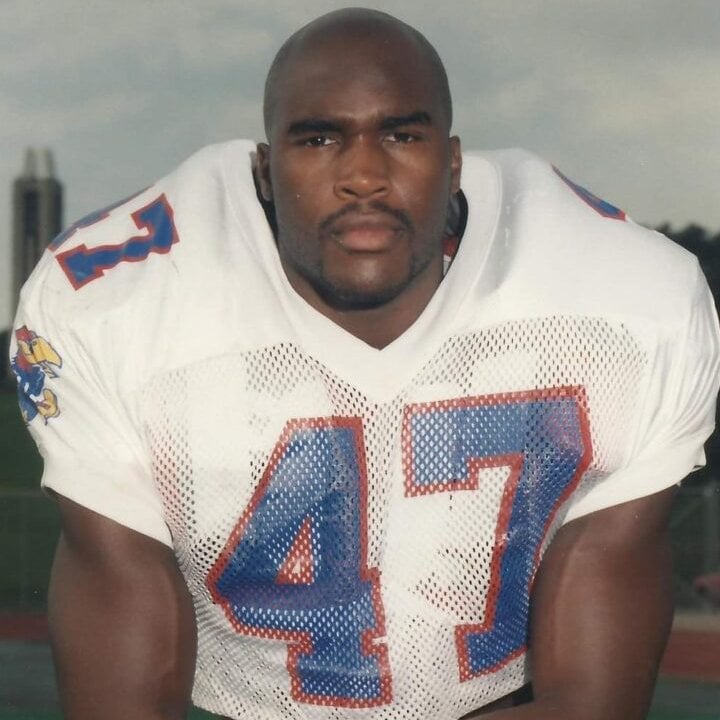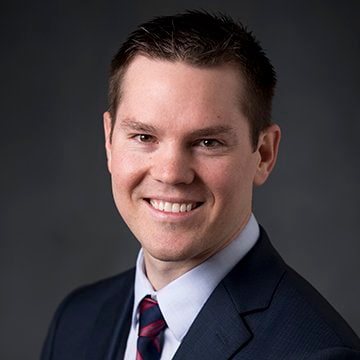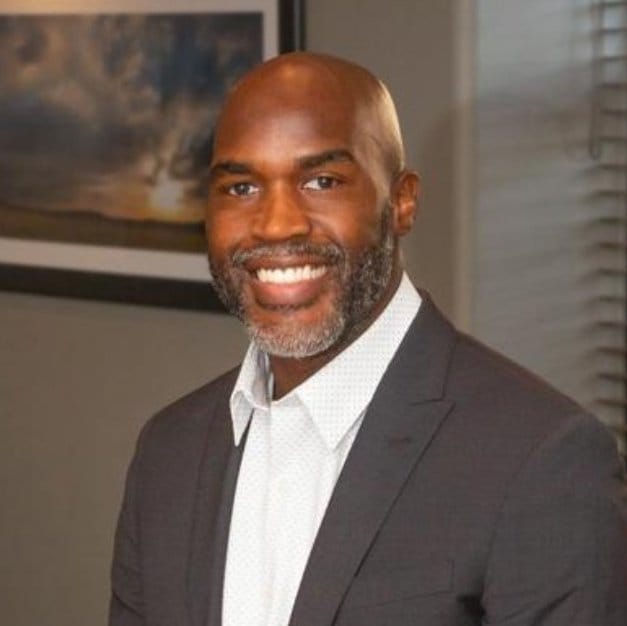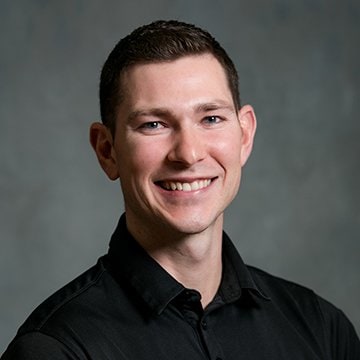Double knee replacement helps return patient to his active life

Pat Brown, Kansas Football 1994-99
Being active is in Pat Brown’s DNA. As an outside linebacker with the University of Kansas football from 1994-99, he jokes that he played on concrete that was painted green. It wasn’t concrete, of course, but the turf was hard on his joints.
“I remember a number of guys that I played with. No one would touch them and they’d go down with a knee injury,” he said. “I saw them go through the rehab process and bounce back to play again a season or two later.”
Brown was fortunate not to have any knee issues during the time he was on the field playing for Glenn Mason and Terry Allen. After his football career ended, he still had a competitive fire that he drew upon when playing basketball three to four times per week. The fire still burned bright, but Brown began to notice that he wasn’t getting around quite as easily as he’d like to.
“My knees were just aching. I went to the doctor and they told me that I’d need a knee replacement at some point,” he said. “I thought, ‘Not me. Surely they have to be wrong.’”
Fast forward a few years and Brown really began to notice the ache in his knees. He went to Target with his wife, Cassandra, and after the first few steps, he had to sit down. His legs ached and he could feel the bone-on-bone grind in his knees. Once again, Brown went to the doctor to find relief. He got cortisone shots, physical therapy and followed all of the doctor’s recommendations, but his symptoms weren’t getting any better.
The wear and tear on his knees became more evident, especially as Brown and his family took a vacation to Mexico in 2022.
“I’ve got a high pain tolerance, but it was a good-sized resort and I was miserable walking around,” he shared. “I was physically laboring and couldn’t wait to get in the water or take a hot bath. I called the doctor once we got back and told him something had to change.”
“Who do you see?”
During a chat at the Lawrence Rotary Club, Brown learned that one of his younger colleagues had knee replacement the previous year. He hadn’t thought that someone younger would have knee replacement and Brown asked for the name of the surgeon. That’s when he was introduced to Dr. James Huston, an orthopedic surgeon at OrthoKansas.

Dr. James Huston
“When Pat came to the clinic, we got X-rays of both of his knees,” Dr. Huston said. “Those showed that he had bone-on-bone arthritis in each knee, with quite a bit of bone spur formation as a result.”
It wasn’t a question in Brown’s mind – being active following any treatment was a must. Dr. Huston listened to his needs and recommended total knee replacements. He explained that as long as he took care of his knees, followed through with rehab and didn’t take it to extremes, Brown could return to an active life after surgery.
While that was music to his ears, Brown had one more request. He wanted to replace both knees at the same time. Dr. Huston was hesitant.
“Recovering from one knee replacement is tough. Recovering from both done on the same day is even tougher,” Dr. Huston explained. “There are additional risks when both knees are replaced at the same time, so I typically prefer for patients to stage the surgeries at least a few weeks apart. Pat was a rare exception to the rule.”
Getting ready for surgery is important. Dr. Huston recommends that patients be as active as they can tolerate and add stretching and strengthening exercises both before and after surgery. While there isn’t a special diet for before or after surgery, it’s important for patients to incorporate protein, fruits and vegetables into their meals. Brown was all in.
“I was very much into doing what I needed to prior to surgery,” Brown said. “I did all of the exercises they gave me, drank protein shakes to help with muscle recovery, got things prepared at home and came in with an optimistic attitude.”
Robotic-assisted surgery

Pat Brown today
On July 18, 2023, Brown arrived at the LMH Health Main Campus ready to have his knees replaced and put the day-to-day pain they caused behind him. Dr. Huston chose to perform the surgeries using the MAKO robotic arm, an instrument funded in part by donor support through the LMH Health Foundation. MAKO has been proven to facilitate a shorter hospital stay, typically less pain, and quicker return to function.
“The robotically-assisted technique allows us to plan the knee replacement in three dimensions,” Dr. Huston explained. “We can adjust our plans during surgery for the optimal position and balancing implants in order to fit the bone and balance the soft tissues as well as possible.”
Surgery went off without a hitch. Since Brown had both knees replaced, he was slated to spend the night at LMH. He’d heard people talk about the pain they had after the nerve block wore off after surgery, and he was prepared to be in pain. What he experienced wasn’t anything of the sort.
“My flexibility was great. I was able to get up to 120 or 125 degrees of movement right out of the gate,” Brown said. “They took me for a lap around the floor and I remember doctors coming out to see me because it’s rare to do a bilateral knee replacement. I walked, I did some stairs and I didn’t feel the grinding pain that I had.”
Once the medication wore off, Brown thought that surely he’d be in more pain. He passed the 36-hour mark after surgery and was surprised that he didn’t feel the amount of pain he’d anticipated. Three or four days later, he was even able to begin moving around without using a walker.
The work begins
It’s important to follow through with physical therapy after a knee replacement, and even more so after having both replaced at the same time. Brown knew he wanted to work with Tyrel Reed, a physical therapist at the LMH Health West Campus. His experience as a high-level athlete, having played basketball for the Kansas Jayhawks, and amazing reputation made Reed his first choice.

Tyrel Reed
“I saw Pat on August 7, about three weeks after his surgery. I was amazed at how well he was doing so early on,” Reed said. “He came in without using an assistive device, just walking in normally after a couple of weeks. That just goes to show his level of activity and strength prior to surgery.”
Brown was motivated to get back to his active lifestyle and spent a couple of months working hard in physical therapy. At each visit, Reed took objective measurements to track his progress, looking at Brown’s strength based on his ability to squat or step up, and his range of motion.
“When you’ve had a single knee replacement, you’re focused on restoring the range of motion on one side,” he said. “Even though he had a bilateral knee replacement, I didn’t handle Pat’s therapy differently. It added a focus on both limbs.”
Reed shared that Brown’s background as a college athlete made a difference in recovery. Being a former athlete, seeing progress and knowing the end goal made the process simpler.
“Pat knew it was a mindset. He knew he wasn’t going to get better unless he attacked his rehab at home and at therapy to make sure he was progressing appropriately,” he explained. “He knew his pain limits – what was short-term pain, what was bad, when he could push things and when he should back off.”
Brown said having Cassandra by his side through the whole process, making sure he took his medication on time - day, night and late night – was a blessing.
“Cassandra reminded me about drinking enough water every day and was there to take me to rehab,” Brown said. “I want to give her flowers for everything she did. She was amazing throughout the whole process.”
Looking to the future
Recovering from a knee replacement takes time, effort and a willingness to work hard to get better. Dr. Huston explained that it typically takes about a year to fully improve in terms of balance, endurance and strength.
“Everyone starts from a unique position entering a joint replacement, so it’s important to set your own goals and not try to compare yourself to someone whose situation isn’t exactly like yours,” he said. “As long as you work hard in the rehab process and we all do our part along the way, most patients can find success after a joint replacement.”
With two new knees and rehab behind him, Brown’s future looks bright. He’s been amazed with the care he received from Dr. Huston, Reed and the team at OrthoKansas. He’s not quite back to playing basketball yet, but that’s his ultimate goal. That and of course, getting back out to tailgate for the Jayhawks next season.
“OrthoKansas and LMH Health care about the patient as a whole. They kept my wife involved along the way and I didn’t feel like a number,” Brown said. “The team was focused on listening to what I wanted and worked to create the best plan to get me feeling better and back to my life.”